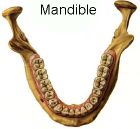Articulation
So far on our journey we have learned how the airstream is created (respiration), how it sets the vocal folds into action, creating a buzz (phonation), and that buzz is modified by the airspace above the larynx (resonation). Now we will explore how the air and vibration passing through the vocal tract are shaped by the articulators into speech sounds.
- Moveable articulators
-
are structures that can move and allow us to shape the sound, i.e. the jaw, the lips and other facial muscles, the tongue, the soft palate, and the pharynx;
- Fixed articulators
-
are those that cannot be moved by muscles, namely the hard palate and the teeth.
There are two major types of articulators:
Most of the images on these page are "clickable" - follow the link to a larger version of the image, which will pop up in a new window. Close the window to return to the page you started from.
Anatomy of Articulation
- Jaw (on this page)
- Facial Muscles
- Tongue
- intrinsic muscles
- extrinsic muscles
- Pharyngeal Constrictors
- Palates
- Hard Palate
- Soft Palate
The Jaw
 The Jaw bone or Mandible, viewed here from the front, hangs off
the skull suspended by a sling formed of muscles attached to the ramus
of each side of the bone. The ramus is the vertical part of the mandible.
The Masseter muscle, forms the sling on the outside of the ramus; the
lateral and medial pterygoid muscles on the inside. The masseter can
be felt by placing a hand just in front of you ear and then clenching your
jaw. To feel the pterygoids, you must place your fingers inside your mouth
- be careful not to bite your fingers as you contract your jaw muscles!
The Jaw bone or Mandible, viewed here from the front, hangs off
the skull suspended by a sling formed of muscles attached to the ramus
of each side of the bone. The ramus is the vertical part of the mandible.
The Masseter muscle, forms the sling on the outside of the ramus; the
lateral and medial pterygoid muscles on the inside. The masseter can
be felt by placing a hand just in front of you ear and then clenching your
jaw. To feel the pterygoids, you must place your fingers inside your mouth
- be careful not to bite your fingers as you contract your jaw muscles!
 From the side, one can see the shape of the ramus a bit more clearly
(this is the inside of the right half of the mandible). The lateral pterygoid
will attach to the inside to the condyle, the bump at the top back of the
mandible and to the skull just under the cheekbone. Its contraction pulls
the jaw forward. The medial pterygoid muscle attaches to the bottom corner
of th mandible and connects to the skull up behind the upper molars at back
of the mouth.
From the side, one can see the shape of the ramus a bit more clearly
(this is the inside of the right half of the mandible). The lateral pterygoid
will attach to the inside to the condyle, the bump at the top back of the
mandible and to the skull just under the cheekbone. Its contraction pulls
the jaw forward. The medial pterygoid muscle attaches to the bottom corner
of th mandible and connects to the skull up behind the upper molars at back
of the mouth.
 From above, you can see how thick the condyle of the mandible is. This
hooks into the capsule of the jaw hinge and works in a very subtle manner
to rotate and drop as the jaw opens. The narrowness of the ramus allows plenty
of space for the masseter on the outside and the pterygoids on the inside.
From above, you can see how thick the condyle of the mandible is. This
hooks into the capsule of the jaw hinge and works in a very subtle manner
to rotate and drop as the jaw opens. The narrowness of the ramus allows plenty
of space for the masseter on the outside and the pterygoids on the inside.
- Jaw (on this page)
- Facial Muscles
- Tongue
- intrinsic muscles
- extrinsic muscles
- Pharyngeal Constrictors
- Palates
- Hard Palate
- Soft Palate
Back to The Journey of the Voice
On to The Care of the Voice...
More on Articulation
Anatomy
of the Pharynx
Emory University, in Atlanta GA, presents materials as part of their Human
Anatomy course. This detailed page on the Pharynx also contains some
info on the larynx.

